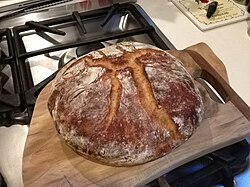No-knead bread

Bread baked using the no-knead method
|
|
| Type | Bread |
|---|---|
| |
|
No-knead bread is a method of bread baking that uses a very long fermentation (rising) time instead of kneading to form the gluten strands that give the bread its texture. It is characterized by a low yeast content and a very wet dough. Some recipes improve the quality of the crust by baking the bread in a Dutch oven or other covered vessel.
According to one version of the method developed by New York baker Jim Lahey, as described in his book My Bread, one loaf of the bread is made by mixing 400 g (approximately 3 cups) bread flour, 8 g (approximately 1¼ teaspoons) salt and 1 g (approximately ¼ teaspoon) instant yeast with 300 mL (approximately 1 1/3 cups) cool water to produce a 75% hydration dough.
The dough is allowed to rise, covered, for 12 to 18 hours until doubled in size and covered with bubbles, then scraped onto a floured surface, given a few folds, shaped, then allowed to rise, covered, for another hour or two. It is then dropped in a pot that has been preheated in an oven at 230 °C (446 °F). The bread is baked in the covered pot for 30 minutes and, with the lid removed, for another 15 to 30 minutes until the crust is a deep brown, then removed from the pot and allowed to cool for an hour.
The method uses a long rise instead of kneading to align the dough's gluten molecules with each other so as to produce a strong, elastic network, resulting in long, sticky strands. The automatic alignment is possible because of the wetness of the dough, which makes the molecules more mobile. Wet doughs, which use a water weight of about 75% that of the flour (hydration), require more salt than conventional doughs, about 2% of the flour weight.
Although no-knead bread was thought to have been first described in the 1999 cookbook No Need to Knead, written by California baker Suzanne Dunaway and published by Hyperion Books, author Jeff Hertzberg notes such a method before the late 1990s in Italy. One reviewer described Dunaway's cookbook as "a book that doesn’t care about kneading and still produces fantastic results!" Due to the popularity of her no-knead method, Dunaway's book was re-published in 2012 by Grub Street Cookery. In addition, famed gospel composer and song collector Albert E. Brumley published a recipe for "No-Knead Bread" in his 1972 song collection and cookbook, All-Day Singin' and Dinner on the Ground, with a similar baking and rising process.
...
Wikipedia
